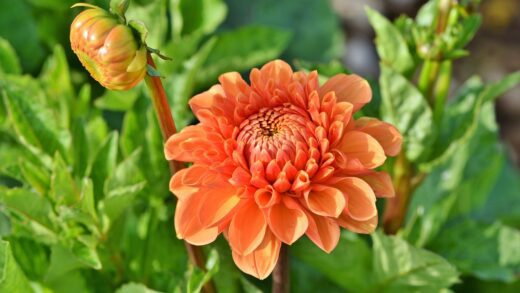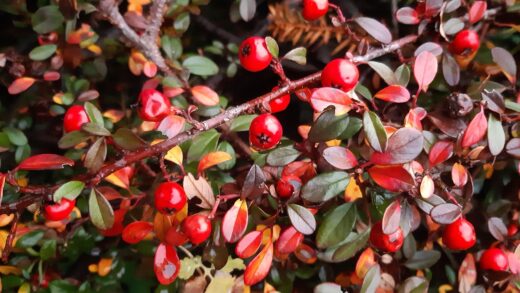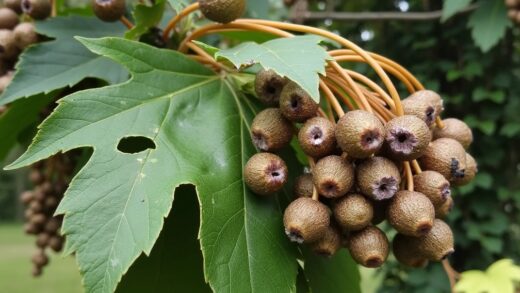Pruning is a vital horticultural practice that shapes the future of an Asian persimmon tree, influencing its structure, health, and the quality and quantity of its fruit. It is a deliberate and skillful intervention that, when done correctly, encourages the tree to grow in a way that is both strong and productive. Far from being a mere cosmetic exercise, pruning is a strategic conversation with the tree, guiding its energy towards developing a sturdy framework capable of supporting a heavy crop and creating an open canopy where sunlight can ripen every fruit. Mastering the principles of when and how to prune is essential for any grower seeking to maximize the potential of their persimmon tree.
The fundamental objectives of pruning a persimmon tree change as the tree matures, but the underlying principles remain the same. For a young tree, the focus is on formative pruning to establish a strong, well-balanced structure. For a mature tree, the goals shift to maintenance pruning, which involves maintaining the tree’s size and shape, removing unproductive wood, and ensuring good light penetration throughout the canopy. A properly pruned tree is not only more productive but also healthier, as the improved air circulation helps to reduce the incidence of fungal diseases.
Understanding the fruiting habit of the Asian persimmon is crucial for making intelligent pruning decisions. Persimmons produce flowers, and therefore fruit, on the current season’s new growth, which arises from buds on the previous year’s shoots. This means that indiscriminate or excessive cutting back of last year’s wood will directly reduce the number of potential fruits for the upcoming season. Pruning must therefore be a careful balance between removing unwanted growth and retaining a sufficient amount of one-year-old wood to ensure a good harvest.
The timing of the pruning is also a critical factor. The vast majority of pruning on persimmon trees should be conducted during the dormant season, typically in late winter or early spring, just before the tree begins to break bud. Pruning during this period minimizes stress on the tree and allows the grower to clearly see the branching structure without the obstruction of leaves. Summer pruning is generally limited to the removal of suckers, watersprouts, or any branches that are broken or diseased, as heavy summer pruning can reduce the tree’s energy-producing capacity.
The goals and principles of pruning persimmon trees
The primary goal of pruning any persimmon tree is to develop a strong structural framework. A well-structured tree has a central leader or several main scaffold branches that are well-spaced and have strong, wide-angled attachments to the trunk. This robust architecture is essential to prevent branches from breaking under the weight of a heavy fruit load, snow, or ice. Pruning in the early years is focused almost entirely on establishing this durable and long-lasting framework.
More articles on this topic
A second major goal is to improve light penetration into the tree’s canopy. Sunlight is the fuel for fruit production and is essential for the development of high-quality, sweet, and well-colored fruit. Pruning to create an open, uncluttered canopy allows sunlight to reach the inner and lower branches, making more of the tree productive. This is achieved by removing crossing branches, branches that grow towards the center of the tree, and any excess growth that creates dense, shaded areas.
Another key principle of pruning is to promote good air circulation. A dense, tangled canopy traps moisture and humidity, creating an ideal environment for fungal diseases like leaf spot and anthracnose to thrive. By thinning out the branches and opening up the tree, pruning allows air to move freely through the canopy, which helps the foliage to dry more quickly after rain or dew. This simple cultural practice is one of the most effective ways to prevent many common diseases.
Finally, pruning is used to manage the size and shape of the tree, remove dead, diseased, or damaged wood, and stimulate the growth of new, productive fruiting wood. By selectively removing older, less productive branches, the grower can encourage the tree to produce new shoots, which will bear the following year’s crop. This process of renewal is essential for maintaining the long-term productivity and vigor of the persimmon tree.
Formative pruning for young trees
Formative pruning during the first few years after planting is the most important pruning a persimmon tree will ever receive. The goal during this period is to establish a strong scaffold system. The most commonly recommended structure for persimmons is the modified central leader system. This system maintains a dominant central trunk in the early years, with three to five main scaffold branches selected and encouraged to grow at wide angles from the trunk. These main branches should be well-spaced both vertically and radially around the trunk.
More articles on this topic
At the time of planting, a young bare-root or containerized tree may need its first pruning cut. If the tree is an unbranched whip, it should be headed back to a height of about 75-90 centimeters to encourage the growth of side branches. If the tree already has branches, select the strongest and best-positioned one to be the central leader and choose a few other well-spaced side branches to become the first scaffold limbs. Any other branches that are too low, too crowded, or have weak, narrow crotch angles should be removed.
During the first two to three dormant seasons, the focus remains on refining this structure. Each winter, you should re-establish the dominance of the central leader by shortening it slightly and cutting back any competing upright stems. Continue to select new scaffold branches as the tree grows taller, aiming for a total of four to six main limbs that are spaced about 20-30 centimeters apart vertically along the trunk. Remove any branches that are growing directly opposite each other on the trunk or that are trying to grow back into the center of the tree.
By the end of the third or fourth year, the main framework of the tree should be well established. At this point, the central leader can be cut back to the topmost scaffold branch to limit the tree’s ultimate height and create a more open-center or vase-like shape in the upper part of the tree. This completes the “modified” aspect of the central leader system and transitions the tree towards a maintenance pruning phase. This early investment in structural pruning will pay dividends for the entire life of the tree.
Maintenance pruning for mature trees
Once a persimmon tree has reached its desired size and its main framework is established, the focus of pruning shifts to maintenance. The goal of maintenance pruning is to preserve the tree’s structure, maintain its productivity, and prevent it from becoming overly dense or large. This is typically done annually during the dormant season and involves a more subtle and selective approach than the formative pruning of a young tree.
The first step in maintenance pruning is to inspect the tree and remove any wood that is dead, damaged, or showing signs of disease. These branches are unproductive and can serve as a source of infection, so their removal is a matter of basic orchard sanitation. Next, look for and remove any suckers growing from the base of the trunk or vigorous, upright shoots growing from the main branches, which are known as watersprouts. These growths are vegetative and rarely produce fruit, and they divert energy from the productive parts of the tree.
After this initial cleanup, the next step is to make thinning cuts to maintain an open and light-filled canopy. Identify and remove branches that are crossing over or rubbing against each other, as well as any that are growing back towards the center of the tree. If two branches are growing too close together and competing for the same space, remove the weaker or less well-positioned one. The goal is to maintain good spacing between the branches to ensure that sunlight and air can move freely throughout the tree.
Finally, some light heading back of the outer branches may be necessary to control the overall size of the tree and to encourage the growth of new fruiting wood. Remember that persimmons fruit on new growth, so it is important to leave plenty of healthy one-year-old shoots. A good strategy is to prune to encourage a continuous cycle of renewal, where you retain a mix of one-year-old fruiting wood and also make cuts that will stimulate the growth of new shoots for the following year’s crop.
Renovation pruning for older or neglected trees
Older persimmon trees that have been neglected for many years can become a dense, tangled mess of unproductive wood. While bringing such a tree back into a healthy and productive state can be challenging, a careful and patient approach to renovation pruning can often achieve remarkable results. It is important to recognize that this process should not be done all at once; a severe, drastic pruning can shock the tree and stimulate a massive, unmanageable explosion of watersprouts.
The renovation process should be spread out over a period of two to three years. In the first year, the focus should be on a major cleanup. Start by removing all dead, diseased, and broken branches. Then, identify the main scaffold branches that will form the new framework of the tree and remove any major competing limbs, especially large, upright branches that are shading the center of the tree. This initial, heavy pruning will open up the tree significantly and is often enough for the first dormant season.
In the second year, you can begin the more detailed work of thinning out the canopy. The tree will likely have responded to the first year’s pruning by producing a large number of watersprouts. Select a few of the best-placed watersprouts to become new, productive branches and remove the rest. Continue to thin out the old, crowded, and crossing branches, always prioritizing the removal of wood that blocks light from reaching the interior of the tree.
By the third year, the tree should be starting to take on a much healthier and more open shape. The final stage of the renovation involves fine-tuning the structure, removing the last of the unwanted old wood, and beginning to manage the new growth that has been stimulated by the pruning. Once the renovation is complete, the tree can be moved onto a regular annual maintenance pruning schedule to keep it in a healthy, productive, and manageable state for years to come.
Timing and tools for effective pruning
The optimal time to perform the majority of structural and maintenance pruning on Asian persimmon trees is during the late dormant season. This typically falls in the period from late winter to early spring, after the risk of the most severe winter cold has passed but before the tree’s sap begins to flow and the buds start to swell. Pruning during dormancy is less stressful for the tree and allows the pruner to clearly see the entire branch structure without the interference of leaves, making it easier to make good decisions.
Using the right tools is essential for making clean, precise cuts that will heal quickly. For smaller branches, up to about two centimeters in diameter, a pair of sharp, high-quality bypass pruners is the tool of choice. Bypass pruners have a cutting blade that sweeps past a hook, making a clean slicing cut that does not crush the plant tissue. For branches that are too thick for hand pruners, a pair of long-handled loppers will provide the necessary leverage.
For larger limbs, a sharp pruning saw is required. Pruning saws are designed to cut on the pull stroke, which gives the user better control and results in a cleaner cut. When removing a large, heavy branch, it is crucial to use the three-cut method to prevent the weight of the branch from tearing the bark down the side of the trunk. This involves making an undercut first, followed by the main cut further out on the limb, and finally a clean finishing cut to remove the remaining stub.
Regardless of the tool being used, it is imperative that the blades are kept sharp and clean. Sharp tools make clean cuts that heal faster, reducing the risk of disease infection. It is also a good practice to disinfect your pruning tools between trees, or even between cuts if you are removing diseased wood. This can be done easily by wiping the blades with a cloth soaked in rubbing alcohol or a 10% bleach solution, which helps to prevent the spread of pathogens from one tree to another.


















